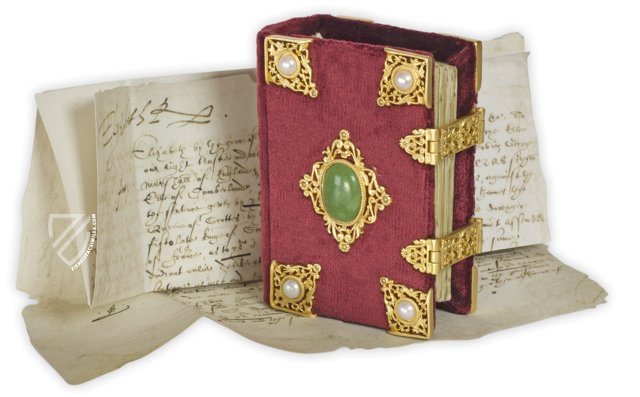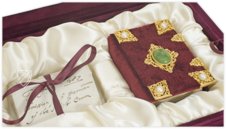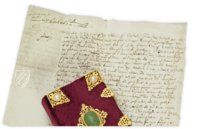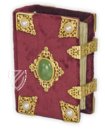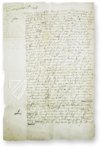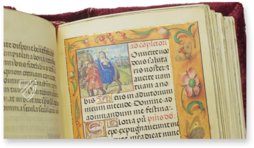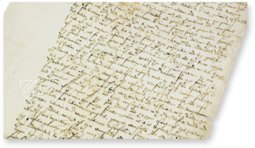Mary Stuart's Book of Hours and Execution Warrant
(3,000€ - 7,000€)
Mary Stuart, the Catholic Queen of Scotland, was the owner of a wondrous book of hours with numerous Flemish miniatures. These are counted among the best of what exists from 16th illumination in Flanders. Precious small paintings are depicted in gorgeous, luminous colors and are gilded in many places. This gem of illumination is accompanied by a document steeped in history: the execution warrant of Mary Stuart, signed by Queen Elizabeth I on February 1st, 1587. This compendium offers a glimpse into the life of one of the most tragic figures in history.
Mary Stuart's Book of Hours and Execution Warrant
Mary Stuart, the Catholic Queen of Scotland and France, was the owner of a wonderful book of hours with numerous Flemish miniatures. This is counted among the most beautiful surviving specimens of early 16th century Flemish illumination. Valuable small paintings are depicted in gorgeous, luminous colors, splendidly gilded in some places. This gem of illumination is accompanied by a document steeped in history: the Execution Warrant of Mary Stuart, signed by the English Queen Elizabeth I on February 1st, 1587. This compendium offers a glimpse into the life of one of the most tragic figures in history.
A Tragic Document
The commissioner of the book of hours was the famous Mary Stuart (1542–1587). The Catholic Queen of Scotland had to abandon her country because of political and religious unrest and flee to England. New tensions with the Queen of England, Elizabeth I, nourished Mary Stuart’s hopes for the English throne. After she was suspected to have participated in a planned assassination attempt, she was executed for high treason on February 7th, 1587. The death sentence, which is dated February 1st, 1587, carries the signature of Queen Elizabeth I at the bottom of the page. Today this death sentence is stored in the Lambeth Palace Library and represents an important testimonial of English history.
The Book of Hours: Her Solace in the Last Hours
The book of hours was the private prayer book of the Queen, which accompanied her in her final hours. It gave her solace and relief as she prayed from it and pressed it to her heart. Nothing was closer to her in the hours of mortal fear than her book of hours. Through her confessor, who came from Ravenna, it eventually came to Italy, where it is stored today in the Biblioteca Classense di Ravenna. Both artifacts, the book of hours in the format of 10 x 7.1 cm and the warrant of execution, are sumptuously stored in a wooden case. The manuscript is protected by a wonderful binding of Bordeaux-red velvet, which is embellished with a jade stone and pearls on the edges of the front side.
The Private Prayer Book of the Scottish Queen
A true world of wonder spreads out before the eye of the beholder on 385 pages. 41 full-page miniatures adorn the private prayer book of Mary Stuart that was probably made in the early 16th century in Flanders, either in Bruges or Ghent. An unknown Flemish master adorned the text with numerous precious initials and artful miniatures. The spiritual text is preceded by a calendar depicting the months on seven pages along with the corresponding zodiac signs. Gorgeous wide frames that are exceedingly colorful and designed with elements of floral tendrils surround the text. In turn, the frames of the calendar pages show rustic genre scenes, e.g. the thresher at work between the streets of a Flemish city.
The Miniatures of the Book of Hours
The 19 miniature pages are extremely artfully designed, while a broad frame always surrounded the actual miniature in the middle of the picture. The frames are filled with naturalistic depictions of fruits, leaves, and flowers, but also with small animals and insects. The miniatures, designed like individual panel paintings, illustrated the texts of the various biblical scenes, e.g. the Annunciation or the Savior of the World. These are painted with great artistry, showing some wonderful landscape or architectural interior as a background. The luminous colorfulness of the paintings is impressive, which is further underscored through the application of gold. Stylistically the miniatures refer to an origin in Flanders, either from Ghent or Bruges. Great names from the art of illumination such as Jan van Eyck, Simon Bening, or Gerard David come to mind.
Codicology
- Alternative Titles
- Stundenbuch und Hinrichtungsurkunde der Maria Stuart
Libro d'Ore di Maria Stuarda
Execution Warrant of Mary Queen of Scots
Stundenbuch der Maria Stuart
Hinrichtungsurkunde für Maria Stuart
Ravenna Hours of Mary, Queen of Scots - Size / Format
- 1 document + 360 pages / 10.0 × 7.1 cm
- Origin
- Belgium
- Date
- Early 16th century (Book of Hours) February 1st, 1587 (Execution Warrant)
- Epochs
- Style
- Language
- Script
- Gothic Textura (Book of Hours)
- Illustrations
- 20 full-page miniatures, illuminated borders and numerous decorated initials
- Content
- Book of Hours + contemporary copy of the original warrant for the execution of Mary, Queen of Scots, made for Henry Grey, 6th Earl of Kent and one of the principal commissioners for her trial and execution
- Artist / School
- Book of Hours: Unknown Flemish Master
Execution Warrant: Robert Beale, Clerk of Privy Coucil (1541–1601) (annotations and underlinings) - Previous Owners
- Book of Hours: Maria Stuart, Queen of Scotland (1542–67)
Execution Warrant: Henry Grey, 6th Earl of Kent (1541–1616); John Selden (1584–1654); Sir Matthew Hale (1609–1676); James Fairhurst (d. 1999); John Burton
Mary Stuart's Book of Hours and Execution Warrant
June: Harvesting Hay
Three farmers harvest hay in a typical labor of the month scene for June. The man on the left cuts the hay with a scythe, going back and forth in rows, which the man in the middle collects with a pitchfork to put into a pile. This pile is then raked by the woman on the right before it is rolled into bales. Hay was an important resource in a world dependent upon the labor of horses, donkey, mules, and oxen. Military campaigns were especially dependent on the availability of grass and hay.
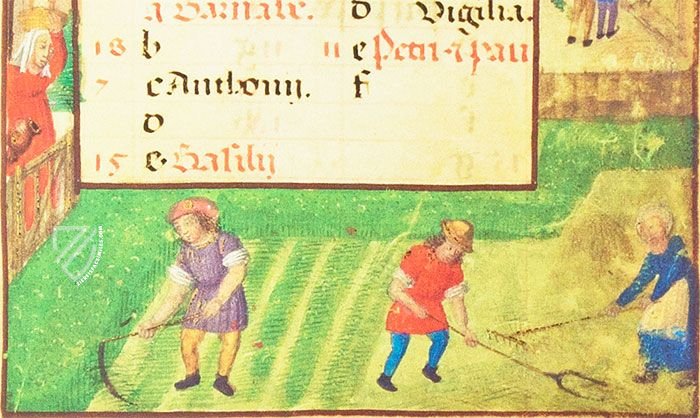
Mary Stuart's Book of Hours and Execution Warrant
Salvator Mundi
Salvator Mundi or “Savior of the World” is a common subject of Christian iconography depicting Christ with his right hand raised in a gesture of benediction while holding a globus cruciger or “cross-bearing orb” in the left. The latter object symbolizes Christ’s dominion over the Earth. This depiction is presented in a lovely golden frame with flowers and butterflies.
Christ is depicted looking at the beholder with a penetrating gaze and an enigmatic expression on his face. He is dressed in a purple tunic with a red cloak secured around his shoulders by a golden, jewel-adorned clasp. Instead of a halo, the Flemish master responsible for the work used fine pen strokes of gold ink to create the image of a cross around Christ’s head.

#1 Libro d'Ore di Maria Stuarda
Language: Italian
(3,000€ - 7,000€)
- Treatises / Secular Books
- Apocalypses / Beatus
- Astronomy / Astrology
- Bestiaries
- Bibles / Gospels
- Chronicles / History / Law
- Geography / Maps
- Saints' Lives
- Islam / Oriental
- Judaism / Hebrew
- Single Leaf Collections
- Leonardo da Vinci
- Literature / Poetry
- Liturgical Manuscripts
- Medicine / Botany / Alchemy
- Music
- Mythology / Prophecies
- Psalters
- Other Religious Books
- Games / Hunting
- Private Devotion Books
- Other Genres
- Afghanistan
- Armenia
- Austria
- Belgium
- Belize
- Bosnia and Herzegovina
- China
- Colombia
- Costa Rica
- Croatia
- Cyprus
- Czech Republic
- Denmark
- Egypt
- El Salvador
- Ethiopia
- France
- Germany
- Greece
- Guatemala
- Honduras
- Hungary
- India
- Iran
- Iraq
- Israel
- Italy
- Japan
- Jordan
- Kazakhstan
- Kyrgyzstan
- Lebanon
- Liechtenstein
- Luxembourg
- Mexico
- Morocco
- Netherlands
- Palestine
- Panama
- Peru
- Poland
- Portugal
- Romania
- Russia
- Serbia
- Spain
- Sri Lanka
- Sweden
- Switzerland
- Syria
- Tajikistan
- Turkey
- Turkmenistan
- Ukraine
- United Kingdom
- United States
- Uzbekistan
- Vatican City
- A. Oosthoek, van Holkema & Warendorf
- Aboca Museum
- Ajuntament de Valencia
- Akademie Verlag
- Akademische Druck- u. Verlagsanstalt (ADEVA)
- Aldo Ausilio Editore - Bottega d’Erasmo
- Alecto Historical Editions
- Alkuin Verlag
- Almqvist & Wiksell
- Amilcare Pizzi
- Andreas & Andreas Verlagsbuchhandlung
- Archa 90
- Archiv Verlag
- Archivi Edizioni
- Arnold Verlag
- ARS
- Ars Magna
- ArtCodex
- AyN Ediciones
- Azimuth Editions
- Badenia Verlag
- Bärenreiter-Verlag
- Belser Verlag
- Belser Verlag / WK Wertkontor
- Benziger Verlag
- Bernardinum Wydawnictwo
- BiblioGemma
- Biblioteca Apostolica Vaticana (Vaticanstadt, Vaticanstadt)
- Bibliotheca Palatina Faksimile Verlag
- Bibliotheca Rara
- Boydell & Brewer
- Bramante Edizioni
- Bredius Genootschap
- Brepols Publishers
- British Library
- C. Weckesser
- Caixa Catalunya
- Canesi
- CAPSA, Ars Scriptoria
- Caratzas Brothers, Publishers
- Carus Verlag
- Casamassima Libri
- Centrum Cartographie Verlag GmbH
- Chavane Verlag
- Christian Brandstätter Verlag
- Circulo Cientifico
- Club Bibliófilo Versol
- Club du Livre
- CM Editores
- Collegium Graphicum
- Collezione Apocrifa Da Vinci
- Comissão Nacional para as Comemorações dos Descobrimentos Portugueses
- Coron Verlag
- Corvina
- CTHS
- D. S. Brewer
- Damon
- De Agostini/UTET
- De Nederlandsche Boekhandel
- De Schutter
- Deuschle & Stemmle
- Deutscher Verlag für Kunstwissenschaft
- DIAMM
- Droz
- E. Schreiber Graphische Kunstanstalten
- Ediciones Boreal
- Ediciones Grial
- Ediclube
- Edições Inapa
- Edilan
- Editalia
- Edition Deuschle
- Edition Georg Popp
- Edition Leipzig
- Edition Libri Illustri
- Editiones Reales Sitios S. L.
- Éditions de l'Oiseau Lyre
- Editions Medicina Rara
- Editorial Casariego
- Editorial Mintzoa
- Editrice Antenore
- Editrice Velar
- Edizioni Edison
- Egeria, S.L.
- Eikon Editores
- Electa
- Emery Walker Limited
- Enciclopèdia Catalana
- Eos-Verlag
- Ephesus Publishing
- Ernst Battenberg
- Eugrammia Press
- Extraordinary Editions
- Fackelverlag
- Facsimila Art & Edition
- Facsimile Editions Ltd.
- Facsimilia Art & Edition Ebert KG
- Faksimile Verlag
- Feuermann Verlag
- Folger Shakespeare Library
- Franco Cosimo Panini Editore
- Friedrich Wittig Verlag
- Fundación Hullera Vasco-Leonesa
- G. Braziller
- Gabriele Mazzotta Editore
- Gebr. Mann Verlag
- Gesellschaft für graphische Industrie
- Getty Research Institute
- Giovanni Domenico de Rossi
- Giunti Editore
- Graffiti
- Grafica European Center of Fine Arts
- Guido Pressler
- Guillermo Blazquez
- Gustav Kiepenheuer
- H. N. Abrams
- Harrassowitz
- Harvard University Press
- Helikon
- Hendrickson Publishers
- Henning Oppermann
- Herder Verlag
- Hes & De Graaf Publishers
- Hoepli
- Holbein-Verlag
- Houghton Library
- Hugo Schmidt Verlag
- Idion Verlag
- Il Bulino, edizioni d'arte
- ILte
- Imago
- Insel Verlag
- Insel-Verlag Anton Kippenberger
- Instituto de Estudios Altoaragoneses
- Instituto Nacional de Antropología e Historia
- Introligatornia Budnik Jerzy
- Istituto dell'Enciclopedia Italiana - Treccani
- Istituto Ellenico di Studi Bizantini e Postbizantini
- Istituto Geografico De Agostini
- Istituto Poligrafico e Zecca dello Stato
- Italarte Art Establishments
- Jan Thorbecke Verlag
- Johnson Reprint Corporation
- Josef Stocker
- Josef Stocker-Schmid
- Jugoslavija
- Karl W. Hiersemann
- Kasper Straube
- Kaydeda Ediciones
- Kindler Verlag / Coron Verlag
- Kodansha International Ltd.
- Konrad Kölbl Verlag
- Kurt Wolff Verlag
- La Liberia dello Stato
- La Linea Editrice
- La Meta Editore
- Lambert Schneider
- Landeskreditbank Baden-Württemberg
- Leo S. Olschki
- Les Incunables
- Liber Artis
- Library of Congress
- Libreria Musicale Italiana
- Lichtdruck
- Lito Immagine Editore
- Lumen Artis
- Lund Humphries
- M. Moleiro Editor
- Maison des Sciences de l'homme et de la société de Poitiers
- Manuscriptum
- Martinus Nijhoff
- Maruzen-Yushodo Co. Ltd.
- MASA
- Massada Publishers
- McGraw-Hill
- Metropolitan Museum of Art
- Militos
- Millennium Liber
- Müller & Schindler
- Nahar - Stavit
- Nahar and Steimatzky
- National Library of Wales
- Neri Pozza
- Nova Charta
- Oceanum Verlag
- Odeon
- Orbis Mediaevalis
- Orbis Pictus
- Österreichische Staatsdruckerei
- Oxford University Press
- Pageant Books
- Parzellers Buchverlag
- Patrimonio Ediciones
- Pattloch Verlag
- PIAF
- Pieper Verlag
- Plon-Nourrit et cie
- Poligrafiche Bolis
- Presses Universitaires de Strasbourg
- Prestel Verlag
- Princeton University Press
- Prisma Verlag
- Priuli & Verlucca, editori
- Pro Sport Verlag
- Propyläen Verlag
- Pytheas Books
- Quaternio Verlag Luzern
- Reales Sitios
- Recht-Verlag
- Reichert Verlag
- Reichsdruckerei
- Reprint Verlag
- Riehn & Reusch
- Roberto Vattori Editore
- Rosenkilde and Bagger
- Roxburghe Club
- Salerno Editrice
- Saltellus Press
- Sandoz
- Sarajevo Svjetlost
- Schöck ArtPrint Kft.
- Schulsinger Brothers
- Scolar Press
- Scrinium
- Scripta Maneant
- Scriptorium
- Shazar
- Siloé, arte y bibliofilia
- SISMEL - Edizioni del Galluzzo
- Sociedad Mexicana de Antropología
- Société des Bibliophiles & Iconophiles de Belgique
- Soncin Publishing
- Sorli Ediciones
- Stainer and Bell
- Studer
- Styria Verlag
- Sumptibus Pragopress
- Szegedi Tudomànyegyetem
- Taberna Libraria
- Tarshish Books
- Taschen
- Tempus Libri
- Testimonio Compañía Editorial
- Thames and Hudson
- The Clear Vue Publishing Partnership Limited
- The Facsimile Codex
- The Folio Society
- The Marquess of Normanby
- The Richard III and Yorkist History Trust
- Tip.Le.Co
- TouchArt
- TREC Publishing House
- TRI Publishing Co.
- Trident Editore
- Tuliba Collection
- Typis Regiae Officinae Polygraphicae
- Union Verlag Berlin
- Universidad de Granada
- University of California Press
- University of Chicago Press
- Urs Graf
- Vallecchi
- Van Wijnen
- VCH, Acta Humaniora
- VDI Verlag
- VEB Deutscher Verlag für Musik
- Verlag Anton Pustet / Andreas Verlag
- Verlag Bibliophile Drucke Josef Stocker
- Verlag der Münchner Drucke
- Verlag für Regionalgeschichte
- Verlag Styria
- Vicent Garcia Editores
- W. Turnowski Ltd.
- W. Turnowsky
- Waanders Printers
- Wiener Mechitharisten-Congregation (Wien, Österreich)
- Wissenschaftliche Buchgesellschaft
- Wissenschaftliche Verlagsgesellschaft
- Wydawnictwo Dolnoslaskie
- Xuntanza Editorial
- Zakład Narodowy
- Zollikofer AG


